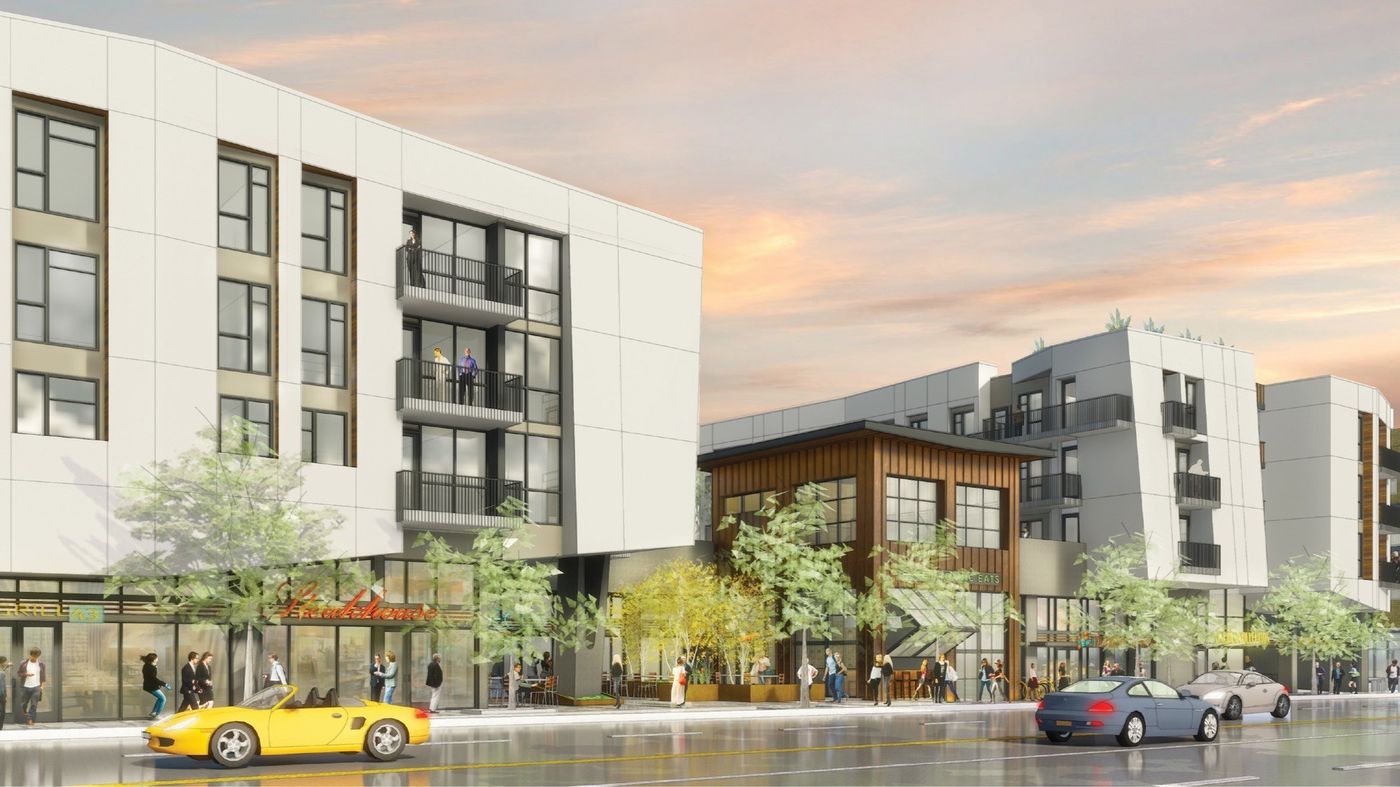
A KFA rendering of a mixed-use complex. (KFA Los Angeles)
Just as concepts of wellness have infiltrated travel, food and fitness, they’re now reaching into residential real estate.
In a so-called wellness community, a diverse, multigenerational population of mixed-income residents are encouraged to interact in beautified and walkable public and commercial spaces.
The multifamily compounds are designed to promote physical activity, interaction with nature and connection with the community beyond the property line. You might help tend a community garden or attend regularly scheduled concerts in an outdoor amphitheater.
Ideas about designing for wellness are changing how residential developments are built, incorporating features more common to spa resorts or high-end gyms.
“Developers are spending more time and space on rooftop gardens and common grilling areas, decks and distinct fitness areas,” said Dean Zander, a CBRE executive vice president who specializes in apartments. He has noticed dedicated rooms for yoga, kickboxing, dog washing or bicycle repair popping up in new and remodeled apartments as builders aim “to bring tenants what they want, which is a healthy environment and a shared sense of community.”
“Wellness” is a buzzword that can be misused or gimmicky, but a new report from the Global Wellness Institute offers builders guidelines and a coherent analysis of how existing and new communities can use architecture, landscaping, sustainability and more to encourage social interaction and active lifestyles.
As wellness lifestyle real estate moves from niche to mainstream, the report predicted, “building for wellness will become the norm.” Already, several Southern California developments lead the charge.
In Beverly Hills, architect Ma Yansong of China’s MAD Architects firm is building a huge living wall in his Gardenhouse project that aims to reshape how residents experience nature.
Lise Bornstein, a partner with KFA Architecture in Los Angeles, is building wellness into projects by turning overlooked courtyards, laundry rooms, porches and corridors into attractive spaces for socializing.
KFA’s renovation of West Hollywood’s Hayworth House, an affordable-housing complex for seniors, created a community garden and a protected front porch where residents can safely connect to the outdoors and the neighborhood.
Residents at Mosaic, a KFA multigenerational community in Los Angeles, can watch a children’s playground from an adjacent laundry room with translucent windows, aiding safety and easing multitasking.
At New Genesis Apartments, KFA flanked an exterior stairwell in cleverly placed yellow siding that resembles a dancing man, hoping it would become an inviting alternative to using the elevator. The 398 luxury apartments the firm designed at Next on Sixth in Koreatown are rich in amenities such as a 70-foot swimming pool, a yoga room, golf range, massage room, spa, party room and four roof decks.

Kelly Wearstler-designed interiors of the long- and short-term rentals available at Hollywood Proper. (Proper Residences)
At the Hollywood Proper Residences, a tower of long- and short-term luxury apartment rentals within the Columbia Square development, the health-focused design was built to meet the Well Building Standard, a performance-based system that measures, certifies and monitors such features as building materials, cleaning products, water and air quality and access to daylight and fitness facilities.
In the 11 months that Charlie Schloredt, 25, has lived in Hollywood Proper, he’s come to appreciate the social and physical amenities of the tower. The energy-efficient lighting, appliances, non-toxic cleaning supplies and air and water filters have had a noticeable effect.
“My allergies are nowhere near what they used to be,” he said. Schloredt runs his financing company, Merchant Financial Services, from the shared office space at the next-door NeueHouse Hollywood and finds little need to drive after his workday. “I moved into this building for the convenience of it,” he said. His social life is practically built-in, too. With a calendar of building-sponsored free daily activities, he now knows most of his neighbors.
According to Sara Neff, senior vice president of sustainability for the Kilroy Realty Corp., the Proper tower offers the world’s first Well-certified rental units. The project also boasts of its resort-like interior design by Kelly Wearstler, its walkability score of 95 and its pet-friendly policies.
“When we originally bought the project, the entitlements were for podium parking, and the site would have had big walls on the street level. At a cost of millions of dollars, we sunk all the parking because we wanted that connectivity with the neighborhood,” Neff said. “It was expensive but totally worth it.”
Of course, developers are becoming savvy to the benefits of building for the health of their tenants. A suite of wellness amenities helps attract renters and keep them longer, Zander said.



